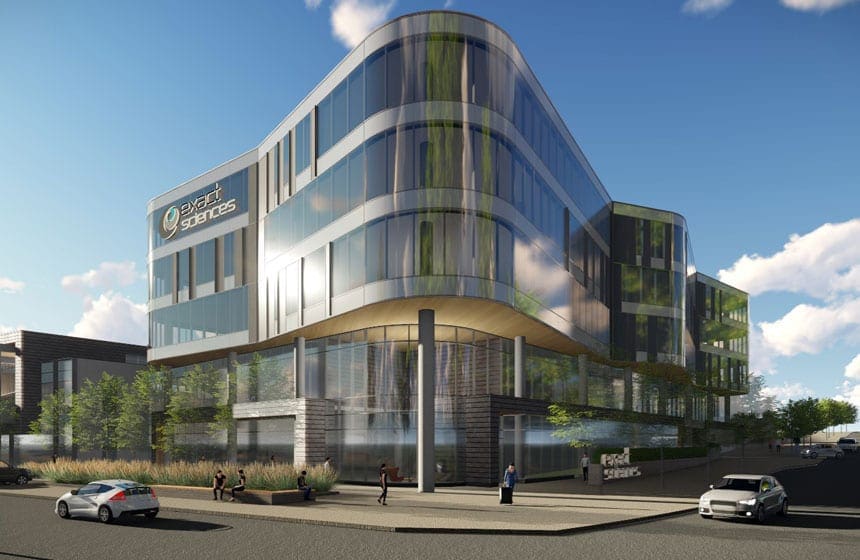By Aaron Olver
By this time in 2020, University Research Park’s footprint, the portfolio of labs and offices we manage, will be 40% larger than it was in 2010. Our growth reflects an underlying trend that’s not always obvious: From nascent research in lab petri dishes to scaling players investing in new facilities, Madison’s life science cluster is booming.
Unlike healthcare IT, Madison’s life science scene isn’t dominated by one highly visible juggernaut like Epic Systems. Exact Sciences, though, may be a contender for that title.
 Exact’s growth is increasingly visible through facilities across the community. Working with Exact, University Research Park is constructing the company’s new headquarters in the park to complement research and development and operations facilities here. Just across the beltline, Exact is building out another campus to accommodate its growing workforce, some 1,800 strong in Madison.
Exact’s growth is increasingly visible through facilities across the community. Working with Exact, University Research Park is constructing the company’s new headquarters in the park to complement research and development and operations facilities here. Just across the beltline, Exact is building out another campus to accommodate its growing workforce, some 1,800 strong in Madison.
Elsewhere in the community, life science leaders such as Promega, Catalent and Shine Medical Technologies are all working on new facilities.
Startups and scaling companies have always been University Research Park’s bread and butter. Companies in the park such as Invenra, Flugen and Nimble Therapeutics have recently closed funding rounds of $7 million, $5.6 million and $10 million, respectively.
The new Forward BioLabs, the laboratory-equivalent of a co-working space, will stretch venture funding like this farther and complement our existing 100,000 square foot incubator, the MGE Innovation Center. Companies will be able to start at a Forward BioLabs bench in a fully-equipped lab and scale through our portfolio until they need their own campus.
I remember a time, not so long ago, when policymakers wrung their hands about Madison-based companies being snatched up and relocated by global corporations. Novagen and Third Wave are two companies from the park that come to mind. While any dynamic, high-growth technology ecosystem will see some of that churn, today there are bountiful examples of acquisitions leading to reinvestment and job growth here in Madison. I see examples in University Research Park and beyond.
Gov. Tony Evers, U.S. Rep. Mark Pocan, D-Wis., and UW-Madison Chancellor Rebecca Blank recently cut the ribbon on an expansion of a University Research Park facility where Stratatech, now a Mallinckrodt company, will manufacture products.
Next door, Fujifilm is investing $21 million to create a state-of-the art facility for developing and making stem cells.
Illumina bought University Research Park tenant Epicentre in 2011; later this year, Illumina will open the doors on a new facility more three times the size of Epicentre’s footprint.
Roche dropped Mirus Bio’s RNAi business after that 2008 acquisition, but Arrowhead Pharmaceuticals picked up that baton and just reached a major milestone. In fact, Arrowhead’s growth in the park left a smaller facility available for Fujifilm’s Cellular Dynamics to grow into.
On the far west side, Accuray has doubled down on Madison since buying UW-Madison radiation therapy spinout, Tomotherapy.
When you dissect the data, Madison’s technology sectors, primarily life sciences and software, are large and growing. These sectors are creating family-supporting jobs, hiring UW-Madison graduates. Thanks to efforts such as Exact Science’s partnership with the Urban League or BioForward’s Women in Biohealth initiative, the sector’s jobs are increasingly inclusive.
Perhaps most important, the life science community is working on innovations that will save lives. Fortunately, I don’t need the data to tell me this: I can just look out my window.
Olver is managing director of University Research Park in Madison and a member of the board of directors for the Wisconsin Technology Council, which is headquartered in URP.



